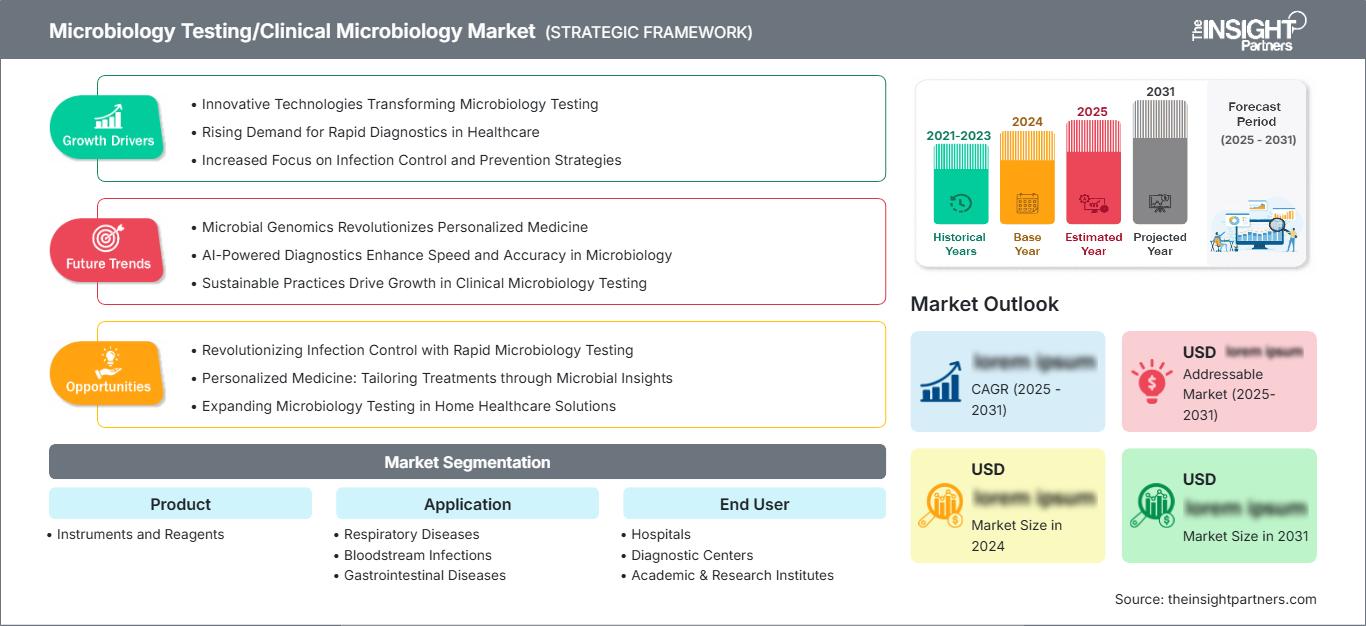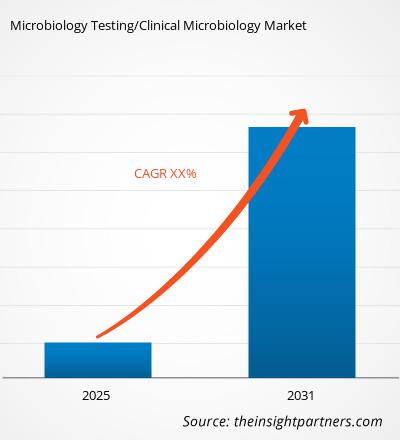Le marché des tests de microbiologie ou de la microbiologie clinique devrait atteindre 10,51 milliards de dollars américains d'ici 2031. Ce marché devrait enregistrer un TCAC de 7,8 % entre 2025 et 2031.
Le rapport est structuré par produit (instruments et réactifs) et analyse le marché par application (maladies respiratoires, infections du sang, maladies gastro-intestinales, maladies parodontales, infections urinaires, infections sexuellement transmissibles). Il examine également le marché par utilisateur final (hôpitaux, centres de diagnostic, établissements d'enseignement et de recherche). Une analyse détaillée est fournie aux niveaux mondial, régional et national pour chacun de ces segments clés.
Le rapport inclut la taille du marché et les prévisions pour tous les segments, exprimées en dollars américains. Ce rapport fournit également des statistiques clés sur la situation actuelle des principaux acteurs du marché, ainsi que des informations sur les tendances actuelles et les opportunités émergentes.
Objectif du rapport
Le rapport « Marché des tests de microbiologie/microbiologie clinique » de The Insight Partners vise à décrire le paysage actuel et la croissance future, les principaux facteurs de croissance, les défis et les opportunités. Il fournira des informations précieuses à divers acteurs du secteur, tels que :
- Fournisseurs de technologies/Fabricants : Pour comprendre l’évolution de la dynamique du marché et identifier les opportunités de croissance potentielles, afin de prendre des décisions stratégiques éclairées.
- Investisseurs : Pour réaliser une analyse approfondie des tendances concernant le taux de croissance du marché, les projections financières et les opportunités tout au long de la chaîne de valeur.
- Organismes de réglementation : Pour encadrer les politiques et les activités du marché afin de minimiser les abus, préserver la confiance des investisseurs et garantir l’intégrité et la stabilité du marché.
Segmentation du marché des tests de microbiologie/microbiologie clinique : Produits
- Instruments et réactifs
Applications
- Maladies respiratoires
- Infections du sang
- Maladies gastro-intestinales
- Maladies parodontales
- Infections urinaires
- Infections sexuellement transmissibles
Utilisateurs finaux
- Hôpitaux
- Centres de diagnostic
- Instituts universitaires et de recherche
Vous bénéficierez d’une personnalisation sur n’importe quel rapport - gratuitement - y compris des parties de ce rapport, ou une analyse au niveau du pays, un pack de données Excel, ainsi que de profiter d’offres exceptionnelles et de réductions pour les start-ups et les universités
Marché des tests de microbiologie/microbiologie clinique: Perspectives stratégiques

- Obtenez les principales tendances clés du marché de ce rapport.Cet échantillon GRATUIT comprendra une analyse de données, allant des tendances du marché aux estimations et prévisions.
Facteurs de croissance du marché des tests microbiologiques/de la microbiologie clinique
- Technologies innovantes transformant les tests microbiologiques
- Demande croissante de diagnostics rapides dans le secteur de la santé
- Accent accru sur les stratégies de contrôle et de prévention des infections
Tendances futures du marché des tests microbiologiques/de la microbiologie clinique
- La génomique microbienne révolutionne la médecine personnalisée
- Les diagnostics basés sur l'IA améliorent la rapidité et la précision en microbiologie
- Les pratiques durables stimulent la croissance des tests de microbiologie clinique
Opportunités du marché des tests microbiologiques/de la microbiologie clinique
- Révolutionner le contrôle des infections grâce aux tests microbiologiques rapides
- Médecine personnalisée : adapter les traitements grâce aux connaissances microbiennes
- Développement des tests microbiologiques dans les solutions de soins de santé à domicile
Marché des tests microbiologiques/de la microbiologie clinique
Les analystes de The Insight Partners ont analysé en détail les tendances régionales et les facteurs influençant le marché des tests de microbiologie/de la microbiologie clinique tout au long de la période prévisionnelle. Cette section aborde également les segments et la répartition géographique du marché de la gestion des troubles du rythme cardiaque en Amérique du Nord, en Europe, en Asie-Pacifique, au Moyen-Orient et en Afrique, ainsi qu'en Amérique du Sud et centrale.
Portée du rapport sur le marché des tests microbiologiques/de la microbiologie clinique
| Attribut de rapport | Détails |
|---|---|
| Taille du marché en 2024 | US$ XX Billion |
| Taille du marché par 2031 | US$ 10.51 Billion |
| TCAC mondial (2025 - 2031) | 7.8% |
| Données historiques | 2021-2023 |
| Période de prévision | 2025-2031 |
| Segments couverts |
By Produit
|
| Régions et pays couverts | Amérique du Nord
|
| Leaders du marché et profils d'entreprises clés |
|
Densité des acteurs du marché des tests microbiologiques/de la microbiologie clinique : comprendre son impact sur la dynamique commerciale
Le marché des tests de microbiologie/de la microbiologie clinique connaît une croissance rapide, portée par une demande croissante des utilisateurs finaux. Cette demande est alimentée par des facteurs tels que l'évolution des préférences des consommateurs, les progrès technologiques et une meilleure connaissance des avantages du produit. Face à cette demande croissante, les entreprises élargissent leur offre, innovent pour répondre aux besoins des consommateurs et tirent parti des tendances émergentes, ce qui stimule davantage la croissance du marché.

- Obtenez le Marché des tests de microbiologie/microbiologie clinique Aperçu des principaux acteurs clés
Points clés de la vente
- Couverture exhaustive : Ce rapport analyse en détail les produits, services, types et utilisateurs finaux du marché des tests microbiologiques/de la microbiologie clinique, offrant ainsi une vision globale.
- Analyse d'experts : Ce rapport repose sur une connaissance approfondie du secteur, acquise grâce à l'expertise d'analystes et de spécialistes reconnus.
- Informations actualisées : Ce rapport garantit la pertinence des informations pour les entreprises grâce à sa couverture des dernières tendances et informations.
- Options de personnalisation : Ce rapport peut être personnalisé pour répondre aux besoins spécifiques des clients et s'adapter parfaitement à leurs stratégies commerciales.
Ce rapport d'étude de marché sur les tests microbiologiques/la microbiologie clinique peut donc contribuer à décrypter et comprendre le contexte sectoriel et les perspectives de croissance. Malgré quelques points à améliorer, les avantages globaux de ce rapport tendent à surpasser ses inconvénients.
- Analyse historique (2 ans), année de base, prévision (7 ans) avec TCAC
- Analyse PEST et SWOT
- Taille du marché Valeur / Volume - Mondial, Régional, Pays
- Industrie et paysage concurrentiel
- Ensemble de données Excel
Rapports récents
Rapports connexes
Témoignages
Raison d'acheter
- Prise de décision éclairée
- Compréhension de la dynamique du marché
- Analyse concurrentielle
- Connaissances clients
- Prévisions de marché
- Atténuation des risques
- Planification stratégique
- Justification des investissements
- Identification des marchés émergents
- Amélioration des stratégies marketing
- Amélioration de l'efficacité opérationnelle
- Alignement sur les tendances réglementaires




















 Obtenez un échantillon gratuit pour - Marché des tests de microbiologie/microbiologie clinique
Obtenez un échantillon gratuit pour - Marché des tests de microbiologie/microbiologie clinique